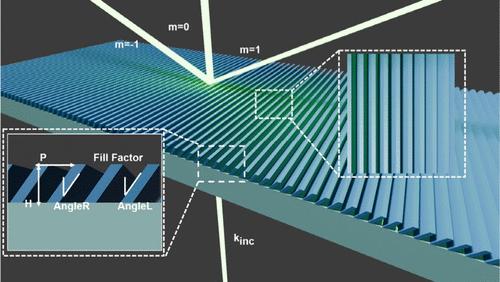Scalable Wafer-Level Fabrication of Slanted TiO2 Gratings for Directional Visible Light Control
IF 9.1
1区 材料科学
Q1 CHEMISTRY, MULTIDISCIPLINARY
引用次数: 0
Abstract
Slanted TiO2 gratings serve as key couplers enabling high-efficiency, large-angle diffraction in augmented reality (AR) diffractive optical waveguide systems, thereby supporting compact and transparent display integration. However, fabrication challenges and high production costs have hindered their scalability. Here, we demonstrate a streamlined and high-fidelity pattern transfer framework, integrating interference lithography, nanoimprint lithography, inductively coupled plasma etching, and reactive ion beam etching. This framework enables one-step pattern replication and precise angular control across wafer-scale areas. An experimental demonstration of the slanted TiO2 grating confirms high structural fidelity and effective phase modulation, enabling efficient directional light steering toward desired diffraction orders. Our work offers a practical and scalable fabrication strategy for implementing slanted TiO2 gratings in AR systems, advancing their feasibility for large-scale integration and commercial deployment.

用于定向可见光控制的倾斜TiO2光栅的可扩展晶片级制造
倾斜的TiO2光栅作为关键耦合器,在增强现实(AR)衍射光波导系统中实现高效率、大角度衍射,从而支持紧凑、透明的显示集成。然而,制造挑战和高生产成本阻碍了它们的可扩展性。在这里,我们展示了一个流线型和高保真的图案转移框架,集成了干涉光刻,纳米压印光刻,电感耦合等离子体蚀刻和反应离子束蚀刻。该框架支持一步模式复制和跨晶圆尺度区域的精确角度控制。斜TiO2光栅的实验验证了高结构保真度和有效的相位调制,实现了有效的定向光转向所需的衍射顺序。我们的工作为在AR系统中实现倾斜TiO2光栅提供了一种实用且可扩展的制造策略,提高了其大规模集成和商业部署的可行性。
本文章由计算机程序翻译,如有差异,请以英文原文为准。
求助全文
约1分钟内获得全文
求助全文
来源期刊

Nano Letters
工程技术-材料科学:综合
CiteScore
16.80
自引率
2.80%
发文量
1182
审稿时长
1.4 months
期刊介绍:
Nano Letters serves as a dynamic platform for promptly disseminating original results in fundamental, applied, and emerging research across all facets of nanoscience and nanotechnology. A pivotal criterion for inclusion within Nano Letters is the convergence of at least two different areas or disciplines, ensuring a rich interdisciplinary scope. The journal is dedicated to fostering exploration in diverse areas, including:
- Experimental and theoretical findings on physical, chemical, and biological phenomena at the nanoscale
- Synthesis, characterization, and processing of organic, inorganic, polymer, and hybrid nanomaterials through physical, chemical, and biological methodologies
- Modeling and simulation of synthetic, assembly, and interaction processes
- Realization of integrated nanostructures and nano-engineered devices exhibiting advanced performance
- Applications of nanoscale materials in living and environmental systems
Nano Letters is committed to advancing and showcasing groundbreaking research that intersects various domains, fostering innovation and collaboration in the ever-evolving field of nanoscience and nanotechnology.
 求助内容:
求助内容: 应助结果提醒方式:
应助结果提醒方式:


